|
Science Takes Center Stage at Expo
50,000 Roll Up Sleeves and Take Part in Science Festival Celebration at Balboa Park
Ioana Patringenaru | April 6, 2009
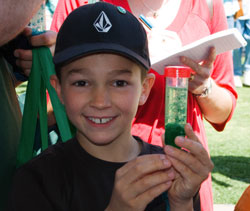
An 8-year-old participant in the Science Expo at Balboa Park holds up a lava lamp he made with help from members of UCSD's Biomedical Engineering Society.
They learned how scientists can use fluorescent proteins to peer at the mechanisms inside cells—work that earned UC San Diego researcher Roger Tsien the Nobel Prize. They got to drive robots designed by Calit2 that are deployed to disaster areas to assess damage. They played with moving sculptures designed by high school students with the help of UC San Diego students.
About 50,000 San Diego County residents gathered in Balboa Park Saturday to take part in a science expo that featured more than 300 hands-on activities put on by about 250 organizations, including UC San Diego. The expo was the culmination of the first-ever San Diego Science Festival, the brainchild of Larry Bock, an entrepreneur and one of the festival’s lead organizers. During the monthlong celebration, scientists, including UCSD professors, visited local schools. Students also visited local campuses and companies.
“It’s gratifying to see how much of a magnetic force this has been,” Bock said.
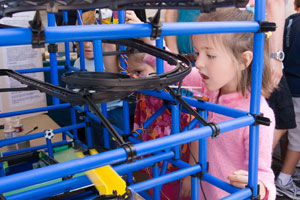
A young girl watches a moving sculpture built by high school students during a summer program at UCSD.
UCSD’s BioBridge, a science education and outreach program that works with several San Diego County school districts, collaborated with the San Diego Science Alliance, Connect, BIOCOMM and other key players to organize the festival. Officials said they hoped the event would get more youths excited about science.
“We have to catch them while they’re young,” said Ramesh Rao, the director of the San Diego division of the California Institute for Telecommunications and Information Technology, also known as Calit2. “If you wait until high school, it’s too late.”
Saturday in Balboa Park, Rao said he had just spoken to a sixth-grader, who asked him what he needed to do to get into UCSD. “This is a great place to have this conversation,” he said. Calit2 had brought some high-tech gizmos to convince young students that science can be fun. At the institute’s booth, dozens of children lined up to get a chance to drive Gizmo, a cross between a remote-controlled toy truck and a smaller sibling of the robots currently roving around Mars. Gizmo is designed to be deployed after a disaster, survey the damage and decide whether it’s safe for humans to come back to the area.
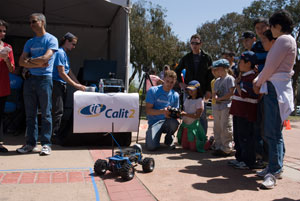
At the Calit2 booth, students got to drive rovers.
“It’s good to bring awareness of what we’re doing and get people excited about this research,” said Alex Hubenko, a program manager at Calit2.
In another part of Balboa Park, students with UCSD’s Biomedical Engineering Society were busy working with a crowd of children who were learning how to make lava lamps with water, oil, food coloring and a little Alka-Seltzer. “We’re trying to encourage students to get into science,” said Melody Chung, a sophomore who studies bioengineering.
Brandon Konig, 8, seemed like he was already convinced. “It’s fun,” he said, holding up his blue-colored lava lamp. Brandon is very interested in all kinds of science, explained his father, LeRoux Konig. “We’ve been having a blast,” the older Konig said.
At another booth, this one showcasing the chemical mechanisms behind the Green Fluorescent Protein that earned UCSD researcher Tsien the Nobel Prize, Don Mackay, a teacher at High Tech High, said he was surprised at students’ enthusiasm Saturday.
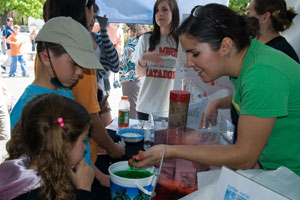
Johnnie Lyman, a graduate student at UCSD's Scripps Institution of Oceanography, explains that micro-organisms found in the ocean feel somewhat like Jell-O.
Mackay is part of the Socrates fellowship program, which pairs UCSD graduate students with high school teachers. For the expo, he and his teaching partner, Sam Lasse, who studies biology, were using glow sticks to simulate how fluorescent proteins work. Many children of all ages leaned into the booth and watched as Lasse and High Tech High students mixed hydrogen peroxide with color dyes to generate fluorescence. “It’s fun to watch them as lights go on in their eyes,” Mackay said.
Across the way, Scott Fall, a UCSD graduate student in mechanical engineering, showed off moving sculptures designed by high school students taking part in COSMOS, a four-week summer program on the UCSD campus. Students programmed the controllers that determined the contraptions’ movements and used a computer program to design different parts.
Saturday, dozens of small children crowded around the sculptures. They dropped small plastic balls into the structures and watched as their careened up and down ramps and slides. “They can just stay here and watch this for hours,” said Fall. “And it involves science.”
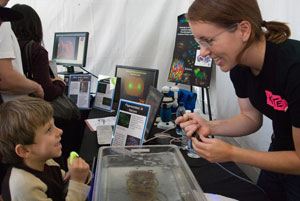
Kate Hanson, a graduate student at UCSD's Scripps Institution of Oceanography, shows visitors how anemones fluoresce.
The Science Festival gave UCSD an unprecedented opportunity to connect a large number of students and their teachers with cutting-edge science, said Loren Thompson, an assistant vice chancellor who oversees several science education and outreach programs, including BioBridge, which helped organize the monthlong event.
The next step is to channel the enthusiasm the festival generated and the connections it created into long-lasting relationships that will impact schools throughout the year, said BioBridge Director Jeremy Babendure.
“The science festival provides a unique opportunity to bring together science professionals, educators, students and the general community to share excitement about science and how it impacts our lives,” Babendure said.

|